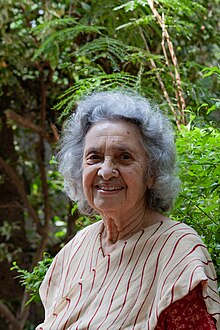| This biography of a living person needs additional citations for verification. Please help by adding reliable sources. Contentious material about living persons that is unsourced or poorly sourced must be removed immediately from the article and its talk page, especially if potentially libelous. Find sources: "Almitra Patel" – news · newspapers · books · scholar · JSTOR (January 2017) (Learn how and when to remove this message) |
| Almitra Patel | |
|---|---|
 Almitra Patel in 2021 Almitra Patel in 2021 | |
| Born | 1936 |
| Alma mater | Bombay University Massachusetts Institute of Technology, USA |
| Known for | Environmental and anti-pollution activism |
Almitra Patel (born 1935) is an Indian environmental policy advocate and anti-pollution activist.
Education
Almitra's father was a businessman and her mother a civic activist, involved with an education society she had founded. Almitra’s was surrounded by science from an early age, and along with her cousin was the first girl to study science at Barnes High School.
Her father wanted her to study engineering, so he sent his daughter to the Massachusetts Institute of Technology (MIT) to pursue higher studies in ceramics. She finished her BSc in General Engineering and MS in Ceramics in three years, and in 1959 she became the first Indian woman engineer to graduate from MIT. Over the next three decades, she worked in the fields of abrasives, foundry-refractories and cement tile industries.
Advocacy and activism
From the 1970s Almitra was also involved in civic and environmental issues, including saving the Asiatic Lions, being a tree warden, saving Ulsoor Lake, solid waste management, and building low cost homes. Almitra went on to become active in environmental policy advocacy. She is currently engaged in solid waste management issues in various think tanks and government panels.
In 1991, Almitra set out to find a solution for hygienic municipal solid waste management, and found that most of the 80 Indian cities she visited in 1994-1995 had nowhere to dump their waste except in the outskirts of the city or approach roads.
Almitra Patel's landmark 1996 Public Interest Litigation in the Supreme Court against the open dumping of municipal solid waste was instrumental in the drafting of the Municipal Solid Waste Management Rules.
She conducted a study on the Ghazipur landfill.
References
- Sarma, Deepika (13 March 2013). "Kothanur's own Renaissance woman". The Hindu. ISSN 0971-751X. Retrieved 28 October 2022.
- Bassett, Ross Knox. The Technological Indian. Cambridge, Massachusetts. ISBN 9780674088986. OCLC 925305899.
- "Almitra Patel: The First Indian Woman Engineer at MIT". sheforsuccess.com. 13 April 2016. Archived from the original on 24 June 2016. Retrieved 16 June 2016.
- Sridhar, Asha (15 August 2013). "A woman's battle to keep waste from ending up in landfills". The Hindu. ISSN 0971-751X. Retrieved 28 October 2022.
- Rehman, Mumtaz (11 July 2021). "Ghazipur Landfill: A Mountain Of Waste Almost The Height Of The Qutub Minar". Feminism in India. Retrieved 28 October 2022.
Further reading
- Krishnan, Lalitha (8 January 2020). "Meet Almitra Patel. The Garbologist who gave India Solid Waste Management Rules". Earthly Matters.
- O'Neill, Kathryn (12 September 2022). "Talking Trash in India". Slice of MIT. MIT Alumni Association.
- Almitra H. Patel and another vs. Union of India. AIR 2000 SCW 924